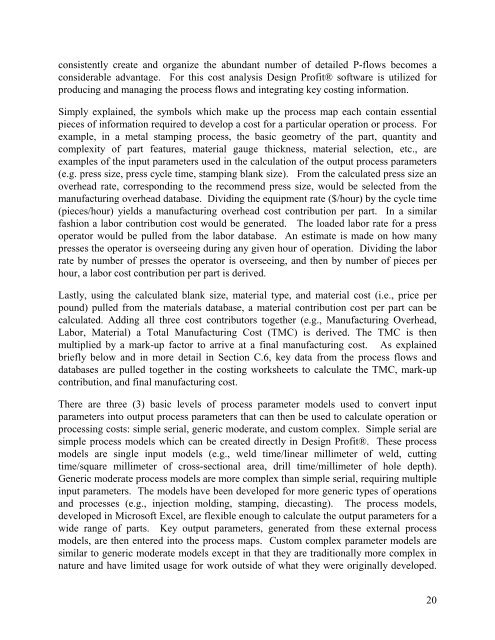Light Duty Technology Cost Analysis, Power - US Environmental ...
Light Duty Technology Cost Analysis, Power - US Environmental ...
Light Duty Technology Cost Analysis, Power - US Environmental ...
Create successful ePaper yourself
Turn your PDF publications into a flip-book with our unique Google optimized e-Paper software.
consistently create and organize the abundant number of detailed P-flows becomes a<br />
considerable advantage. For this cost analysis Design Profit® software is utilized for<br />
producing and managing the process flows and integrating key costing information.<br />
Simply explained, the symbols which make up the process map each contain essential<br />
pieces of information required to develop a cost for a particular operation or process. For<br />
example, in a metal stamping process, the basic geometry of the part, quantity and<br />
complexity of part features, material gauge thickness, material selection, etc., are<br />
examples of the input parameters used in the calculation of the output process parameters<br />
(e.g. press size, press cycle time, stamping blank size). From the calculated press size an<br />
overhead rate, corresponding to the recommend press size, would be selected from the<br />
manufacturing overhead database. Dividing the equipment rate ($/hour) by the cycle time<br />
(pieces/hour) yields a manufacturing overhead cost contribution per part. In a similar<br />
fashion a labor contribution cost would be generated. The loaded labor rate for a press<br />
operator would be pulled from the labor database. An estimate is made on how many<br />
presses the operator is overseeing during any given hour of operation. Dividing the labor<br />
rate by number of presses the operator is overseeing, and then by number of pieces per<br />
hour, a labor cost contribution per part is derived.<br />
Lastly, using the calculated blank size, material type, and material cost (i.e., price per<br />
pound) pulled from the materials database, a material contribution cost per part can be<br />
calculated. Adding all three cost contributors together (e.g., Manufacturing Overhead,<br />
Labor, Material) a Total Manufacturing <strong>Cost</strong> (TMC) is derived. The TMC is then<br />
multiplied by a mark-up factor to arrive at a final manufacturing cost. As explained<br />
briefly below and in more detail in Section C.6, key data from the process flows and<br />
databases are pulled together in the costing worksheets to calculate the TMC, mark-up<br />
contribution, and final manufacturing cost.<br />
There are three (3) basic levels of process parameter models used to convert input<br />
parameters into output process parameters that can then be used to calculate operation or<br />
processing costs: simple serial, generic moderate, and custom complex. Simple serial are<br />
simple process models which can be created directly in Design Profit®. These process<br />
models are single input models (e.g., weld time/linear millimeter of weld, cutting<br />
time/square millimeter of cross-sectional area, drill time/millimeter of hole depth).<br />
Generic moderate process models are more complex than simple serial, requiring multiple<br />
input parameters. The models have been developed for more generic types of operations<br />
and processes (e.g., injection molding, stamping, diecasting). The process models,<br />
developed in Microsoft Excel, are flexible enough to calculate the output parameters for a<br />
wide range of parts. Key output parameters, generated from these external process<br />
models, are then entered into the process maps. Custom complex parameter models are<br />
similar to generic moderate models except in that they are traditionally more complex in<br />
nature and have limited usage for work outside of what they were originally developed.<br />
20

















